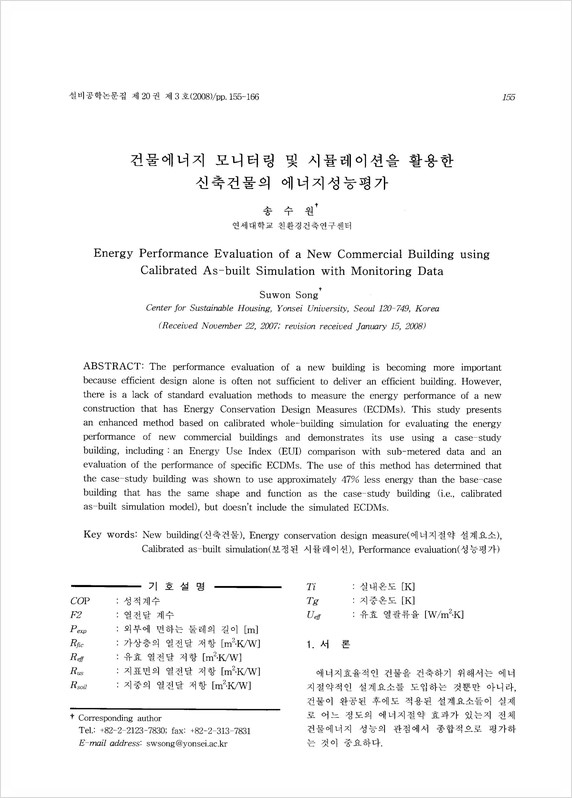건물에너지 모니터링 및 시뮬레이션을 활용한 신축건물의 에너지성능평가
건물에너지 모니터링 및 시뮬레이션을 활용한 신축건물의 에너지성능평가
Energy Performance Evaluation of a New Commercial Building using Calibrated As-built Simulation with Monitoring Data
저자 송수원
소속 연세대학교
학술지정보 설비공학논문집 KCI
발행정보 대한설비공학회 2008년
자료제공처 국회도서관 KISTI 국립중앙도서관 건축도시연구정보센터 한국연구재단
주제분야 공학 > 기타공학
소속 연세대학교
학술지정보 설비공학논문집 KCI
발행정보 대한설비공학회 2008년
자료제공처 국회도서관 KISTI 국립중앙도서관 건축도시연구정보센터 한국연구재단
주제분야 공학 > 기타공학
<초록>
The performance evaluation of a new building is becoming more important because efficient design alone is often not sufficient to deliver an efficient building. However, there is a lack of standard evaluation methods to measure the energy performance of a new construction that has Energy Conservation Design Measures (ECDMs). This study presents an enhanced method based on calibrated whole-building simulation for evaluating the energy performance of new commercial buildings and demonstrates its use using a case-study building, including: an Energy Use Index (EUI) comparison with sub-metered data and an evaluation of the performance of specific ECDMs. The use of this method has determined that the case-study building was shown to use approximately 47% less energy than the base-case building that has the same shape and function as the case-study building (i.e., calibrated as-built simulation model), but doesn't include the simulated ECDMs.
The performance evaluation of a new building is becoming more important because efficient design alone is often not sufficient to deliver an efficient building. However, there is a lack of standard evaluation methods to measure the energy performance of a new construction that has Energy Conservation Design Measures (ECDMs). This study presents an enhanced method based on calibrated whole-building simulation for evaluating the energy performance of new commercial buildings and demonstrates its use using a case-study building, including: an Energy Use Index (EUI) comparison with sub-metered data and an evaluation of the performance of specific ECDMs. The use of this method has determined that the case-study building was shown to use approximately 47% less energy than the base-case building that has the same shape and function as the case-study building (i.e., calibrated as-built simulation model), but doesn't include the simulated ECDMs.
The performance evaluation of a new building is becoming more important because efficient design alone is often not sufficient to deliver an efficient building. However, there is a lack of standard evaluation methods to measure the energy performance of a new construction that has Energy Conservation Design Measures(ECDMs). This study presents an enhanced method based on calibrated whole-building simulation for evaluating the energy performance of new commercial buildings and demonstrates its use using a case-study building, including: an Energy Use Index(EUI) comparison with sub-metered data and an evaluation of the performance of specific ECDMs. The use of this method has determined that the case-study building was shown to use approximately 47% less energy than the base-case building that has the same shape and function as the case-study building(i.e., calibrated as-built simulation mode]), but doesn't include the simulated ECDMs.
<목차>
ABSTRACT 1. 서론 2. 사례연구 대상건물 3. 시뮬레이션 모델 및 조건 4. 결과 및 고찰 5. 결론 후기 참고문헌
ABSTRACT 1. 서론 2. 사례연구 대상건물 3. 시뮬레이션 모델 및 조건 4. 결과 및 고찰 5. 결론 후기 참고문헌














(%EC%A0%9C19819%ED%98%B8)(20250501)001.jpg)
(%EC%A0%9C34657%ED%98%B8)(20240710)001.jpg)
댓글
댓글 쓰기